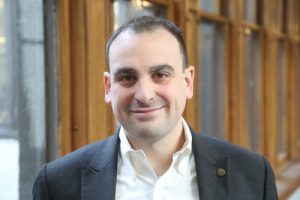Blaming Law Students For A 'Free Speech Crisis' Is Dangerous
Blaming students is cheap and also usually wrong.
 Even among the annals of stupid “campus free speech crisis” stories, Judge Stuart Kyle Duncan’s misadventures at Stanford Law achieved a special level of stupid. The Trump judge’s bid for martyrdom should’ve foundered on the rocks while he sneeringly refused to answer civil questions from and then called a bunch of students appalling idiots. But Stanford’s administration opted to throw minority students under the bus and fire an associate dean anyway just to keep the judge happy.
Even among the annals of stupid “campus free speech crisis” stories, Judge Stuart Kyle Duncan’s misadventures at Stanford Law achieved a special level of stupid. The Trump judge’s bid for martyrdom should’ve foundered on the rocks while he sneeringly refused to answer civil questions from and then called a bunch of students appalling idiots. But Stanford’s administration opted to throw minority students under the bus and fire an associate dean anyway just to keep the judge happy.
But this story isn’t really about Judge Duncan, as much as it’s about the disturbing reality distortion field that’s grown up around the incident. And it doesn’t bode well for free speech.
Judge Charles Breyer made some remarks about the Stanford story during a George Washington University Law event last April featuring Breyer and his brother the former Supreme Court justice. While the comments are almost a year old, they do speak to an ongoing problem.

Generative AI at Work: Boosting e-Discovery Efficiency for Corporate Legal Teams
Q: What do you recommend to students while they’re in law school and what’s your advice for them when they’re starting out in practice?
Charles R. Breyer, Senior District Judge: Sure, and unfortunately, you’ve hit a really responsive note cause I decided maybe I shouldn’t say something about the Stanford students….
Spoiler: He’s going to decide that he should say something about the Stanford students.
… but if you’ve been following that…a member of the Fifth Circuit was invited to speak at Stanford and got to Stanford, it was an appellate court. A Fifth Circuit judge. He got there to speak, and was heckled by the students, with such vigor that he couldn’t get a word out of his speech.
This, mind you, is completely bullshit. The contemporary accounts described Judge Stuart Kyle Duncan “looking more like a YouTuber storming the Capitol.” Video of the incident graced right-wing cable news, but less aggressively edited clips revealed the judge being offered all kinds of time to speak… and using that time refusing to answer civil questions posed by the audience.
Sponsored

AI Presents Both Opportunities And Risks For Lawyers. Are You Prepared?

Curbing Client And Talent Loss With Productivity Tech

Generative AI at Work: Boosting e-Discovery Efficiency for Corporate Legal Teams

Curbing Client And Talent Loss With Productivity Tech
Things appear to have degenerated after Judge Duncan’s sneering contempt for such genuine engagement riled up the crowd — almost as though he showed up with the express purpose of making himself a martyr to boost his profile.
Breyer, who clearly never saw these clips, continued:
And one would think **one would think** that law students, above all, should understand the value of a process where people express contrary and sometimes odious views that they have to be addressed in a civilized way. And so I would just say to law students, look, two things. Number one, realize that there is a process out there for expressing your views. And the smart thing, if you have very strong views about things, is learn how to challenge that. Learn how to present them.
One would think that because it seems as though that was the initial game plan for the Stanford students.
Sponsored

Law Firm Business Development Is More Than Relationship Building

Happy Lawyers, Better Results The Key To Thriving In Tough Times
Where’s he getting this nonsense?
And subsequently the dean wrote a really wonderful letter, 10 pages in length, praised by both the Washington Post and the Wall Street Journal opinion pages as being probably a really terrific exposition of the First Amendment.
As the tipster who flagged this interview noted, how is a federal judge in the 21st century reading the Wall Street Journal editorial page as though it’s tethered to any sort of reality? Remember after Dobbs when they smeared a 10-year-old rape victim who had to travel to Indiana by claiming she didn’t exist? The opinion page is such brazen propaganda that the newsroom side of WSJ has publicly feuded with the opinion editors over their screw-ups.
The problem isn’t so much that Breyer never saw the longer, contextual clips of the Stanford dispute, it’s that he apparently never bothered to seek them out. Yet, he felt comfortable publicly assigning blame to the students without ascertaining what happened. He felt comfortable describing the events in the clip above as the judge “couldn’t get a word out” as he rambles on dismissively after being asked a fair question. And he felt comfortable scolding students for not understanding civilized behavior while a Fifth Circuit judge is calling a student “an appalling idiot.”
It’s the one-sidedness of it all. Even if you want to cast blame upon the students for taking the bait — a fair criticism — that’s not what’s happening in Breyer’s remarks. He’s placing full responsibility upon the students and absolving the comparatively more powerful ostensible adult in the room. Maybe he doesn’t want to critique the behavior of a fellow federal judge? Fine, then don’t say anything at all.
Unfortunately, he’s not been alone in heaping blame first and foremost upon students, and this impulse reflects a deeper threat to open discourse. There’s a concerted effort to recast the whole notion of free speech as a top-down right designed to protect the speaker on stage from criticism. Not just time, place, and manner restrictions on organized protests, but punishment and re-education classes for students acting within the rules but asking questions that the speaker doesn’t like.
Regurgitating the “students are the problem” narrative isn’t helping.
As Breyer put it, “Number one, realize that there is a process out there for expressing your views,” and yet the Stanford example he chooses to drag involves students engaged in what “one would think” is exactly the process he’s talking about and getting shut down. What happens then? That’s the actually interesting free speech dilemma.
Maybe he should’ve stuck with his initial decision and not have said anything.
 Joe Patrice is a senior editor at Above the Law and co-host of Thinking Like A Lawyer. Feel free to email any tips, questions, or comments. Follow him on Twitter if you’re interested in law, politics, and a healthy dose of college sports news. Joe also serves as a Managing Director at RPN Executive Search.
Joe Patrice is a senior editor at Above the Law and co-host of Thinking Like A Lawyer. Feel free to email any tips, questions, or comments. Follow him on Twitter if you’re interested in law, politics, and a healthy dose of college sports news. Joe also serves as a Managing Director at RPN Executive Search.







